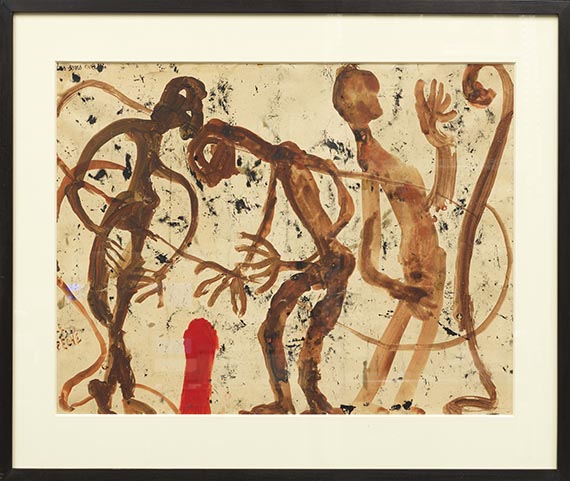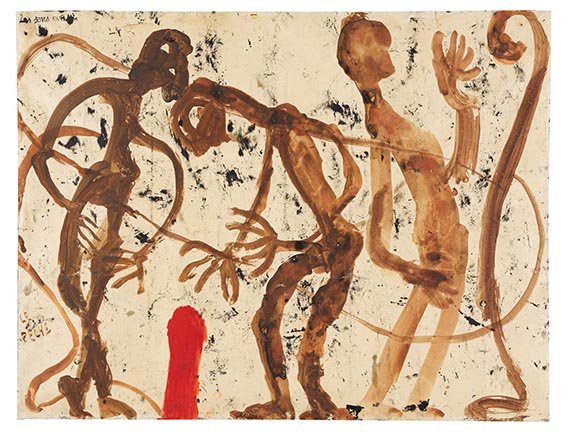33
Louis Soutter
Les peintres et le mur blanc / Le péché - Les sens éveillés (2-seitig), 1939.
Finger painting. Oil and printer's ink, paint
Estimate:
€ 150,000 / $ 177,000 Sold:
€ 254,000 / $ 299,720 (incl. surcharge)
Les peintres et le mur blanc / Le péché - Les sens éveillés (2-seitig). 1939.
Finger painting. Oil and printer's ink, painted on both sides.
Titled and dated in the upper right of the image. The composition on the reverse is titled in the upper left and inscribed "Le peche" in the lower left. On firm off-white paper. 50 x 64.7 cm (19.6 x 25.4 in), the full sheet.
The composition on the back was not executed in finger painting as is the case with the front, but with a brush, a rare occurrence in Soutter's work. [JS].
• Raw and full of existential energy: Soutter's frenetic finger paintings are considered revolutionary creations by an unrecognized genius and early documents of Art Brut.
• Visionary: With his spontaneously executed paintings, Soutter anticipated artistic trends that would later be taken up by artists such as Jean Michel Basquiat.
• “Les peintres et le mur blanc / Le péché - Les sens éveillés”: dense visual reflection on existential themes between painting and sin.
• It is fascinating on both sides: the front is a finger painting, and the back is a rare colored work in brush.
• Comparable works can be found in prominent international collections, including the Museum of Modern Art, New York, the Kunstmuseum Basel, and the Fondation Le Corbusier, Paris.
We are grateful to Prof. Michel Thévoz for his kind expert advice.
PROVENANCE: Gallerie Vallotton, Lausanne (with the hand-written note: "Coll. Valloton N° 15", until at least 1961).
Heinz Teusch, Essen.
Galerie Haas, Berlin.
Private collection, South Germany (acquired form the above around 2005).
EXHIBITION: Louis Soutter. Retrospective, Cantonal Museum of Fine Arts, Lausanne, March 2–May 28, 1961, cat. no. 248 (reverse).
LITERATURE: Michel Thévoz, Louis Soutter. Catalogue de l'œuvre, Zürich 1976, catalogue raisonné no. 2582 (illustrated on the cover, the illustration on the back will be included into the forthcoming digital addenda to the catalog raisonné).
"I am determined to paint and suffer!
Louis Soutter, to hius artist friend Marcel Poncet in 1937.
Finger painting. Oil and printer's ink, painted on both sides.
Titled and dated in the upper right of the image. The composition on the reverse is titled in the upper left and inscribed "Le peche" in the lower left. On firm off-white paper. 50 x 64.7 cm (19.6 x 25.4 in), the full sheet.
The composition on the back was not executed in finger painting as is the case with the front, but with a brush, a rare occurrence in Soutter's work. [JS].
• Raw and full of existential energy: Soutter's frenetic finger paintings are considered revolutionary creations by an unrecognized genius and early documents of Art Brut.
• Visionary: With his spontaneously executed paintings, Soutter anticipated artistic trends that would later be taken up by artists such as Jean Michel Basquiat.
• “Les peintres et le mur blanc / Le péché - Les sens éveillés”: dense visual reflection on existential themes between painting and sin.
• It is fascinating on both sides: the front is a finger painting, and the back is a rare colored work in brush.
• Comparable works can be found in prominent international collections, including the Museum of Modern Art, New York, the Kunstmuseum Basel, and the Fondation Le Corbusier, Paris.
We are grateful to Prof. Michel Thévoz for his kind expert advice.
PROVENANCE: Gallerie Vallotton, Lausanne (with the hand-written note: "Coll. Valloton N° 15", until at least 1961).
Heinz Teusch, Essen.
Galerie Haas, Berlin.
Private collection, South Germany (acquired form the above around 2005).
EXHIBITION: Louis Soutter. Retrospective, Cantonal Museum of Fine Arts, Lausanne, March 2–May 28, 1961, cat. no. 248 (reverse).
LITERATURE: Michel Thévoz, Louis Soutter. Catalogue de l'œuvre, Zürich 1976, catalogue raisonné no. 2582 (illustrated on the cover, the illustration on the back will be included into the forthcoming digital addenda to the catalog raisonné).
"I am determined to paint and suffer!
Louis Soutter, to hius artist friend Marcel Poncet in 1937.
Mysterious, enigmatic, painful, powerful, and always fascinating are the words that come to mind when describing the psychodramatic imagery that Soutter created in the black-and-white finger paintings of his last creative phase. They seem to turn Soutter's vulnerable innermost thoughts inside out, to spread his fears and fantasies out before us in an almost intoxicating manner. This deep, intimate, painterly insight into the soul is disturbing and captivating. According to Michel Thévoz, the phase of large-format finger paintings can be narrowed down to 1937 to 1942, the year of Soutter's death. Before that, in the solitude of his room at the Swiss boarding school Ballaigues, he first created pencil and pen-and-ink drawings with fine lines in a floral-ornamental style and then in a Mannerist style, with which he filled exercise books all over. Soutter's great cousin, the famous architect Le Corbusier, visited him for the first time in Ballaigues in 1927 and, in the following years, campaigned intensively for his work to be recognized. It is also thanks to Le Corbusier that Soutter's works were exhibited in America during his lifetime and that his cousin was henceforth able to obtain suitable drawing materials. Soutter's oeuvre, which piled up after his death in 1942 in the small room of his home that had been his whole world for the last nineteen years, shows not only stylistically progressive creativity but also a technically equally significant step: With the finger paintings that he started creating in 1937, including the present double-sided composition, Soutter anticipated a progressive achievement of later action art, thereby lending his works a uniquely direct aura.
These captivating works impressively document Soutter's escape into an artistic parallel world. His revolutionary work, which negates all traditions, is now considered an early form of Art Brut and is internationally coveted. However, his work was forgotten for a long time until his major one-person show at the Lenbachhaus in Munich and the Kunstmuseum in Bonn (1985). Art historians only rediscovered and celebrated it after the significant Soutter show at the Kunstmuseum Basel (2002). How revolutionary and disturbing must Soutter's black shadow figures from his last creative phase have seemed to contemporary viewers, for whom the work of Penck, Dubuffet, or even Basquiat was still an unknown distance? Never diagnosed as mentally ill, Soutter seems to us today much more as an almost tragically unrecognized genius. He got fired from the symphony orchestra for frequently contradicting superiors and generally misbehaving misbehavior. Once, he ordered 20 silk ties and sent the bill to his brother. These amusing anecdotes could have been told about later artists who got into society's face with their personalities and unconventional art, such as Martin Kippenberger, Jonathan Meese, or Andy Warhol. Soutter's tragic life story is ultimately the story of a failure in a bourgeois society. This maverick and visionary spirit ultimately withdrew himself and his art from any desire to conform. But despite all its tragedy, these painful experiences of failure and exclusion were needed to create such a dense work imbued with the spirit of pain. [JS]
These captivating works impressively document Soutter's escape into an artistic parallel world. His revolutionary work, which negates all traditions, is now considered an early form of Art Brut and is internationally coveted. However, his work was forgotten for a long time until his major one-person show at the Lenbachhaus in Munich and the Kunstmuseum in Bonn (1985). Art historians only rediscovered and celebrated it after the significant Soutter show at the Kunstmuseum Basel (2002). How revolutionary and disturbing must Soutter's black shadow figures from his last creative phase have seemed to contemporary viewers, for whom the work of Penck, Dubuffet, or even Basquiat was still an unknown distance? Never diagnosed as mentally ill, Soutter seems to us today much more as an almost tragically unrecognized genius. He got fired from the symphony orchestra for frequently contradicting superiors and generally misbehaving misbehavior. Once, he ordered 20 silk ties and sent the bill to his brother. These amusing anecdotes could have been told about later artists who got into society's face with their personalities and unconventional art, such as Martin Kippenberger, Jonathan Meese, or Andy Warhol. Soutter's tragic life story is ultimately the story of a failure in a bourgeois society. This maverick and visionary spirit ultimately withdrew himself and his art from any desire to conform. But despite all its tragedy, these painful experiences of failure and exclusion were needed to create such a dense work imbued with the spirit of pain. [JS]
33
Louis Soutter
Les peintres et le mur blanc / Le péché - Les sens éveillés (2-seitig), 1939.
Finger painting. Oil and printer's ink, paint
Estimate:
€ 150,000 / $ 177,000 Sold:
€ 254,000 / $ 299,720 (incl. surcharge)
Headquarters
Joseph-Wild-Str. 18
81829 Munich
Phone: +49 89 55 244-0
Fax: +49 89 55 244-177
info@kettererkunst.de
Louisa von Saucken / Undine Schleifer
Holstenwall 5
20355 Hamburg
Phone: +49 40 37 49 61-0
Fax: +49 40 37 49 61-66
infohamburg@kettererkunst.de
Dr. Simone Wiechers / Nane Schlage
Fasanenstr. 70
10719 Berlin
Phone: +49 30 88 67 53-63
Fax: +49 30 88 67 56-43
infoberlin@kettererkunst.de
Cordula Lichtenberg
Gertrudenstraße 24-28
50667 Cologne
Phone: +49 221 510 908-15
infokoeln@kettererkunst.de
Hessen
Rhineland-Palatinate
Miriam Heß
Phone: +49 62 21 58 80-038
Fax: +49 62 21 58 80-595
infoheidelberg@kettererkunst.de
We will inform you in time.




 Lot 33
Lot 33 

